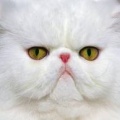
Cats
We love cats



Persian cats.
Description: The Persian is a longhaired cat characterized by its round face and shortened muzzle. Its name refers to Persia, the former name of Iran, where similar cats are found. Recognized by the cat fancy since the late 19th century, it was developed first by the English, and then mainly by American breeders after the Second World War. In Britain, it is called theLonghair or Persian Longhair.
Appearence:
A show-quality Persian has an extremely long thick coat, short legs, a wide head with the ears set far apart, large eyes, and an extremely foreshortened muzzle.
Most popular breed:
Persian Cats have been the most popular cat breed in the world for quite a long time.
History:
The first documented ancestors of the Persian were imported from Persia into Italy in 1620 by Pietro della Valle, and from Turkey into France by Nicholas-Claude Fabri de Peiresc at around the same time. From France they soon reached Britain. The longhaired cats from Persia were interbred with Turkish Angoras. Their appearance then differed greatly from today's standard. Hundreds of years of selective breeding made Persians cobbier cats with drastically shorter muzzle.
The Persian Cat is the most represented cat breed in the cat shows and the Persians are the ongoing leaders in annual ratings by CFA and European cat clubs and associations.
Temprament:
Persian Cats are of calm temperament. The Persian cat is an ideal breed for those who are looking for a

pleasant, peaceful and loyal companion. The Persians is not a talkative breed - if the Persian wants your attention, it would sit before you and gaze loyaly into your eyes.
Colors:
Persian cats can have any color or markings including pointed, golden, tortoiseshell, blue, and tabby.
Equivalent of Persian cat:
The Exotic Shorthair (ES) is the shorthair equivalent of the Persian and Himalayan breeds and is differentiated from the Persian and Himalayan by coat length ONLY. It is accepted in ALL colors. Its plush, dense coat and similar type give the breed a teddy bear-like appearance. The Himalayan (HI) is a man-made hybrid breed identical to the Persian, but distinguished by the points on the cats' extremities (the facial mask, feet, ears, and tail) which results in a Persian-type cat with the coloring and deep blue eyes of the Siamese-patterned cat. The Persian (PS) has a long coat, flowing all over the body with a dense undercoat giving the coat full volume. The ruff should be immense. All traditional, sepia and mink colors are accepted.
Origin:
There are many versions of Persian cat's origin. One of them is that roots of Persian cats went back to Persia (modern Iran). Just there Italian aristocrat and traveller Pietro Della Valle found unusual longhaired cats during his travel in Eastern Europe, Turkey, Persia and India (1614-1626). In his book 'Trip to Turkey, Persia and India in 54 letters' he described in details cats, which he saw in Ishafan (Persia) in 1620. At that time he sent a pair of that grace animals 'with fluffy, long, especially on the neck and tail, fur' to Italy for the breeding. But their further fate stayed unknown.
History:
In 'Natural history' by Fransua-Loui Lekler earl de Buffon, there was given a description of two varieties of longhaired cats, having imported to Europe (the beginning of XVII century) from Afghanistan, Iran and Turkey (native land of Turkish Angora). Painting of that times often reflects the cat similar with her appearance to modern Angora, but cats occur which differ from her with more broad mill of ears, quite expressed transfer from forehead to nose, and thick with evidently expressed undercoat, hair. It gives us a chance to suppose that from the East there was imported not only Turkish Angora, but other variety, survived many names (Asian, Chinese, Russian and others), of eastern longhaired cat, have become a progenitress of Persian.
There is a version, disproving the eastern origin of Persians. The main her point is that, according to the genographic map of spreading of allele L (Long) in natural populations, the most probable native land of owners of long hair is considered to be Russia, where climat was favourable to the developmebt of such hair. And only from there she could be imported to the East as 'exotic wonder'.
All is possible... However, it is hardly possible to foresee the place and logicof formation of mutation.
Another version is probable that by her quite different type and constitution Persian cat is obliged to wild felis manul - this appallingly slow resident of hilly regions of Asia sometimes, when he has a mood, pays definite attention on the local domestic cats. His thickset, 3-4 kg by weight, body in combination with flat face framed with fluffy whiskers, round eyes and little broadly delivered ears really say in favour of this version.
And nevertheless, these and oher existed versions with more or less degree of probability are only suppositions. In reality the history of origin of Persian cat still remains a mystery. That, however, gives us a chance to enrich the collection of these 'probability theory' with not one suppositon.

She shares her feelings and nervousness from first 15 minutes of pregnancy. Probably, it is touchingly, because after some time all your house is involved in the problems of 'kittens bearing.' And all two months are in this way. At the moment of birth not only you will have a milk, but your neighbours too :)